Potřebujeme váš souhlas k využití jednotlivých dat, aby se vám mimo jiné mohly ukazovat informace týkající se vašich zájmů. Souhlas udělíte kliknutím na tlačítko „OK“.
ASTM C1682-09
Standard Guide for Characterization of Spent Nuclear Fuel in Support of Geologic Repository Disposal
Automaticky přeložený název:
Standardní Příručka pro charakterizaci s vyhořelým jaderným palivem na podporu Geologic úložiště Likvidace
NORMA vydána dne 1.6.2009
Informace o normě:
Označení normy: ASTM C1682-09
Poznámka: NEPLATNÁ
Datum vydání normy: 1.6.2009
Kód zboží: NS-12196
Počet stran: 9
Přibližná hmotnost: 27 g (0.06 liber)
Země: Americká technická norma
Kategorie: Technické normy ASTM
Kategorie - podobné normy:
Anotace textu normy ASTM C1682-09 :
Keywords:
cladding, corrosion, damaged fuel, degraded cladding, engineered barrier system (EBS), failed fuel, geologic repository, interim dry storage, SNF transport, spent nuclear fuel (SNF), waste package performance, waste form degradation, zirconium hydride, ICS Number Code 13.030.30 (Special wastes), 27.120.30 (Fissile materials and nuclear fuel technology)
Doplňující informace
| Significance and Use | ||||||||||||||||||||
|
In order to demonstrate conformance to regulatory requirements and support the postclosure repository performance assessment information is required about the attributes, characteristics, and behavior of the SNF need to be determined. These properties of the SNF in turn support the transport, interim storage, and repository preclosure safety analyses, and repository postclosure performance assessment. The interim dry storage of commercial LWR SNF is regulated per Code of Federal Regulations, Title 10, Part 72, which requires that the cladding must not sustain during the interim storage period any “gross” damage sufficient to release fuel from the cladding into the container environment. However, cladding damage insufficient to allow the release of fuel during the interim storage period may still occur in the form of small cracks or pinholes. These cracks/pinholes could be sufficient to classify the fuel as “ failed fuel” or “breached fuel” per the definitions given in Section 3 for repository disposal purposes, because they could allow contact of water vapor or liquid with the spent fuel matrix and thus provide a pathway for radionuclide release from the waste form. Also, pinholes/cracks in fuel rods in dry or wet interim storage can also develop into much larger defects (for example, the phenomenon of cladding “unzipping”) under long-term repository conditions. Therefore SNF characterization should be adequate to determine the amount of “failed fuel” for either usage as required. This could involve the examination of reactor operating records, ultrasonic testing, sipping, and analysis of the residual water and drying kinetics of the spent fuel assemblies or canisters. In the U.S. the disposal of spent nuclear fuel (SNF) and high level waste (HLW) in a geologic repository is regulated under the Code of Federal Regulations, Title 10, Part 60 (which pertains to any geologic repository built in the U.S.), Code of Federal Regulations, Title 10, Part 63 (which pertains to the repository located at Yucca Mountain, Nevada), and Code of Federal Regulations, Title 40, Part 191 (which established the radiation protection levels the repository must meet). Each of these regulations contains constraints and limitations on the chemical or physical (or both) properties and long-term degradation behavior of the spent fuel and HLW in the repository. Evaluating the design and performance of the WF, WP, and the rest of the engineered barrier system (EBS) with respect to these regulatory constraints requires knowledge of the chemical/physical characteristics and degradation behavior of the SNF that could be provided by the testing and data evaluation methods provided by this guide, as follows: Code of Federal Regulations, Title 10, Part 60 Sections 135 and 113 require that the waste form be a material that is solid, non-particulate, non-pyrophoric, and non-chemically reactive, that the waste package contain no liquid, particulates, or combustible materials and that the materials/components of the EBS be designed to provide—assuming anticipated processes and events—substantially complete containment of the HLW for the NRC-designated regulatory period. Code of Federal Regulations, Title 10, Part 63 Section 113 requires that the EBS be designed such that, working in combination with the natural barriers, the performance assessment of the EBS demonstrates conformance to the annual reasonably expected individual dose protection standard of Code of Federal Regulations, Title 10, Part 63 Section 311 and the reasonably maximally exposed individual standard of Code of Federal Regulations, Title 10, Part 63 Section 312, and shall not exceed EPA dose limits for protection of groundwater of Code of Federal Regulations, Title 10, Part 63 Section 331 during the NRC-designated regulatory compliance period after permanent closure. Code of Federal Regulations, Title 10, Part 63 Section 114 (e), (f), and (g) and Code of Federal Regulations, Title 10, Part 63 Section 115 (c) require that a technical basis be provided for the inclusion or exclusion of degradation /alteration processes pertinent to the barriers of the EBS, and that likewise a technical basis be provided for the degradation/alteration models used in the postclosure performance assessment of the capability of the EBS barriers to isolate waste. The enhanced chemical reactivity and degraded condition of corroded/damaged uranium metal-based SNF must be accounted for in both the preclosure safety analyses and the postclosure performance assessment of the geologic repository. An example of this would be the potential for pyrophoric behavior in uranium metal-based SNF (see Guide C 1454). Due to the combustibility of the metallic uranium or uranium hydride (or both), and the enhanced aqueous dissolution rates for the exposed uranium metal, the potential for enhanced chemical activity or pyrophoric behavior must be factored into the repository or interim storage facility safety analyses, and assessments of the potential for radionuclide releases from the repository site boundary after repository closure. Characterization of several key properties of SNF may be required to support the design and performance analyses of both repository above-ground SNF receipt and lag storage facilities, the waste package (WP) into which the SNF is placed, and the subsurface permanent emplacement drift EBS. Repository waste package design must ensure that the waste to be placed in the repository can be accommodated within the radionuclide and thermal loading ranges of the waste package drift emplacement licensing conditions. To do this the radionuclide content and oxidation rate when exposed to oxygen/water environments should be determined. The condition of the LWR spent fuel cladding (particularly with respect to hydride content and morphology) could potentially influence the performance of the cladding in interim storage and repository disposal. The corrosion and consequent failure rate of cladding with high hydride content may be greater than that of low or no hydride content. If the performance assessment is found to be sensitive to the failure rate of the cladding, it may be necessary to perform zirconium hydride content and orientation testing, particularly for high burnup LWR SNF. Metallic uranium-based spent fuel introduces aspects of chemical reactivity, such as combustibility and pyrophoricity (see C 1454), that should be addressed in WP design and performance assessment, and in safety analyses associated with interim storage and transportation prior to repository emplacement. Metallic uranium-based nuclear fuel has been widely used in nuclear reactors; sometimes for commercial reactors (for example, Magnox) but more often in plutonium and tritium production reactors. The manner of discharge of metallic uranium SNF from these production reactors, and/or the manner of temporary wet storage of that portion of the spent fuel that was not reprocessed has in many instances resulted in significant corrosion and mechanical damage to the SNF assemblies. This damage has resulted in the direct exposure of the metallic uranium to the basin water. The relatively high chemical reactivity of uranium in contact with water can result in significant physical damage to the assemblies as the result of corrosion product buildup, and the creation in the exposed fuel surface and fuel matrix of uranium hydride inclusions which in turn further increase the chemical activity of the material. The reaction of this spent fuel with air, water vapor, or liquid water can introduce a significant heat source term into design basis events. In order to support the evaluation of these events, the physical condition (that is, the degree of optically/visually observable damage), the chemical oxidation kinetics, the ignition characteristics, and radionuclide release characteristics of the SNF should be investigated. The thermal analysis of the waste package/engineered barrier system requires quantification of the potential chemical heat source. To determine this, the amount of reactive uranium metal in the waste canisters sent to the repository should be provided so the thermal analysis of the waste package/engineered barrier system can be performed. Radionuclide inventories and physical/chemical characteristics are required to enable waste package loading and emplacement configurations to be developed. Repository waste package materials selection and design must account for the potential interactions between the waste and waste package. The potential chemical forms of the wastes must be considered, and the effects of residual water or impurities (or both) should be evaluated. The history of the SNF interim storage and transportation conditions prior to delivery to the repository is important whenever the storage conditions may have altered the degradation characteristics of the SNF (for example, with respect to hydride content and morphology in high burnup LWR SNF cladding). Interim dry storage of commercial SNF requires that the fuel cladding should not sustain gross damage during the storage period to the extent that fuel is released from the fuel rods into the canister. Small pinholes or cracks may form in the cladding during the storage period without violating this interim storage requirement, but may cause the fuel to be classified as failed fuel for repository disposal purposes. The objective of drying commercial SNF fuel is thus to preclude gross damage for interim storage purposes. If the conditions of transport or interim storage are such that there is a significant potential for further degradation of the SNF or change in properties important to the repository preclosure safety or postclosure performance analyses, the characterization should provide sufficient information to evaluate these changes. |
||||||||||||||||||||
| 1. Scope | ||||||||||||||||||||
|
1.1 This guide provides guidance for the types and extent of testing that would be involved in characterizing the physical and chemical nature of spent nuclear fuel (SNF) in support of its interim storage, transport, and disposal in a geologic repository. This guide applies primarily to commercial light water reactor (LWR) spent fuel and spent fuel from weapons production, although the individual tests/analyses may be used as applicable to other spent fuels such as those from research and test reactors. The testing is designed to provide information that supports the design, safety analysis, and performance assessment of a geologic repository for the ultimate disposal of the SNF. 1.2 The testing described includes characterization of such physical attributes as physical appearance, weight, density, shape/geometry, degree, and type of SNF cladding damage. The testing described also includes the measurement/examination of such chemical attributes as radionuclide content, microstructure, and corrosion product content, and such environmental response characteristics as drying rates, oxidation rates (in dry air, water vapor, and liquid water), ignition temperature, and dissolution/degradation rates. Not all of the characterization tests described herein must necessarily be performed for any given analysis of SNF repository performance, particularly in areas where an extensive body of literature already exists for the parameter of interest. 1.3 It is assumed in formulating the SNF characterization activities in this guide that the SNF has been stored in an interim storage facility at some time between reactor discharge and dry transport to the geologic repository. The SNF may have been stored either wet (for example, a spent fuel pool), or dry (for example, an independent spent fuel storage installation (ISFSI)), or both, and that the manner of interim storage may affect the SNF characteristics. 1.4 The values stated in SI units are to be regarded as standard. No other units of measurement are included in this standard. 1.5 This standard does not purport to address all of the safety concerns, if any, associated with its use. It is the responsibility of the user of this standard to establish appropriate safety and health practices and determine the applicability of regulatory limitations prior to use. |
||||||||||||||||||||
| 2. Referenced Documents | ||||||||||||||||||||
|
Podobné normy:
Historická
1.1.2012
Historická
1.1.2010
Historická
1.6.2011
Historická
1.6.2011
Historická
15.11.2006
Historická
1.5.2010
Doporučujeme:
Aktualizace technických norem
Chcete mít jistotu, že používáte pouze platné technické normy?
Nabízíme Vám řešení, které Vám zajistí měsíční přehled o aktuálnosti norem, které používáte.
Chcete vědět více informací? Podívejte se na tuto stránku.


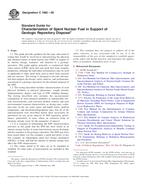
 ASTM C1571-03(2012)..
ASTM C1571-03(2012)..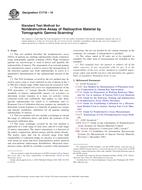 ASTM C1718-10
ASTM C1718-10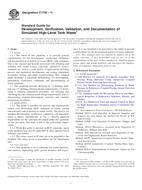 ASTM C1750-11
ASTM C1750-11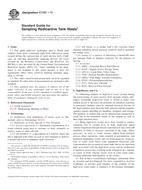 ASTM C1751-11
ASTM C1751-11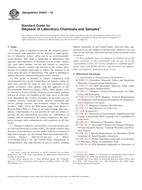 ASTM D4447-10
ASTM D4447-10 ASTM D5608-10
ASTM D5608-10
 Cookies
Cookies
